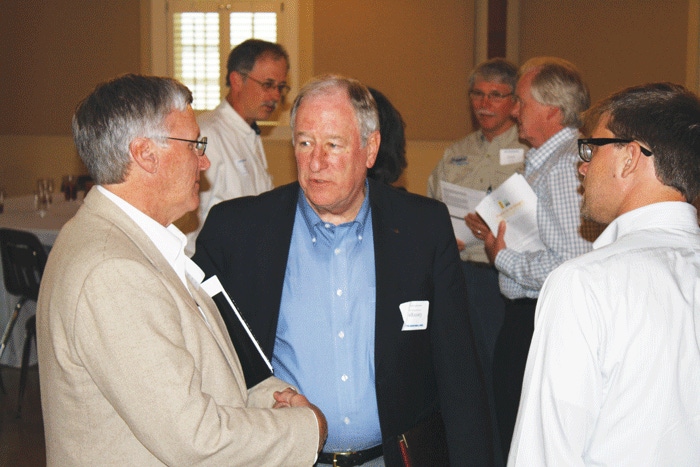
For many, the humble peanut is a kitchen-shelf essential.
Only recently has its nutritional power been used to save and improve lives. George Birdsong calls it the “Halo” effect around peanuts and something the industry is now coming together to bolster and tout.
Thirty five representatives from across the peanut industry met recently at the Methodist Church of Blakely, Ga., to discuss what they can collectively do to organize and expand the industry’s humanitarian activities.
The first such roundtable was held last year prior to the festival. A steering committee was charged then. But getting the collective “arms around such a broad industry effort” has been a challenge.
“This is an industry effort, not just a private effort or just an individual one. And when we see an industry coming together through the growers, the shellers, the manufacturers and all the different groups trying to create, or focus, the humanitarian efforts, I think it is creating a halo around the industry. … We’re not perfect, but we’re trying to do some good here,” said Birdsong, who heads Birdsong Peanuts and led the discussion in Blakely.
Malnutrition and starvation causes more damage to man than AIDS, tuberculosis and malaria combined, suppressing less-developed parts of the world.
The peanut has for many decades been known as a staple nutritional food. But only in the last decade has its energy been harnessed to fight malnutrition and bring much-needed relief to those hurt by natural disasters.
“People are really beginning to realize how valuable peanuts can be,” Birdsong said. “We really do have somewhat of a super food.”
Global aid groups, including UNICEF and the United Nation World Food Program, now use peanut-based, ready-to-use therapeutic foods, or RUTFs. Packaged in several ways, the vitamin-rich paste has become the “Gold Standard” tool to effectively and efficiently fight acute malnutrition around the world. Combined, UNICEF and WFP buy 1,250 metric tons of the stuff annually, said Jamie Rhoads, an agronomist with Meds and Food for Kids, a St. Louis-based non-profit aid group cultivating peanut growth and producing RUTFs in Haiti.
“And that RUTF, peanut-based demand is expected to continue if not increase,” Rhoads said.
Also helps on domestic front
The humanitarian effort is not just an international one. Peanut’s domestic humanitarian effort has been pushed in the last four years by Peanut Proud, a nonprofit- volunteer-based organization based in Blakely.
The group has raised $721,000 to buy and get peanut butter to domestic disasters, most notably in the spring 2011 when storms hit 7 Southeastern states, which resulted in numerous deaths and left thousands homeless, said Gregg Grimsley, who spearheads Peanut Proud’s work.
“We are not as big as other aid groups or have the staff. In fact we have no real staff, we’re all volunteers. So, we have to focus our efforts,” Grimsley said.
As it happens, unfortunately, Southern peanut-producing states most often are hit by devastating tornadoes and hurricanes, and in those 11 peanut-producing states is where Peanut Proud focuses its humanitarian work, Grimsley said.
Peanut Proud, in partnership with Kroger Foods Inc., now has a brand of peanut butter with the “Peanut Proud” label on it. It specifies on each jar that it is a gift from the peanut industry.
So, now what?
Led by the American Peanut Council, a plan is under way to determine how to place industry humanitarian efforts under one umbrella, or at the least get word out on what all is going on and how resources and manpower can be better used or organized, from procuring raw peanuts, to making peanut butter and getting to where it needs to be.
A new organization to handle humanitarian projects? No, all at the roundtable agreed the peanut industry has enough organizations now as it is.
Hire a person charged to keep tabs on all humanitarian efforts? Maybe. Ways to raise funds to pay and equip the person and where to house the person would have to be decided.
Stop or squelch humanitarian efforts under way now? A definite no.
APC plans to complete the industry-wide plan by June.
“I got a clear direction today that the industry wants to do something about hunger, and they want to have local organization continue to do what they are doing and then try to wrap all that up and communicate a larger message about the health and the value of peanuts to consumers,” said Stephanie Grunenfelder, APC’s vice-president for international marketing.
You might also like
Custom planting may be good option this year
New report shows several factors involved in honey bee colony declines
Mudding in corn not a good idea, but here are tips to help minimize problems
Conservation Stewardship Program applications due by May 31
About the Author(s)
You May Also Like






